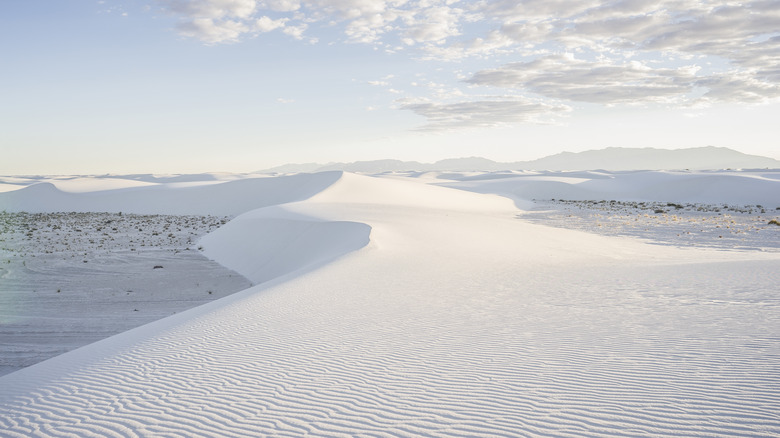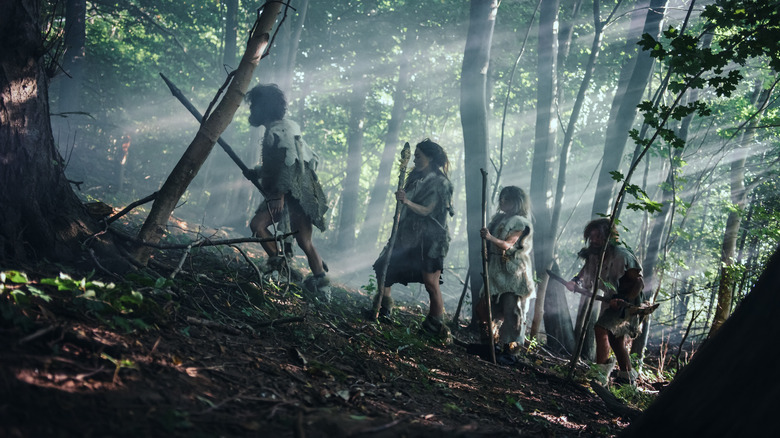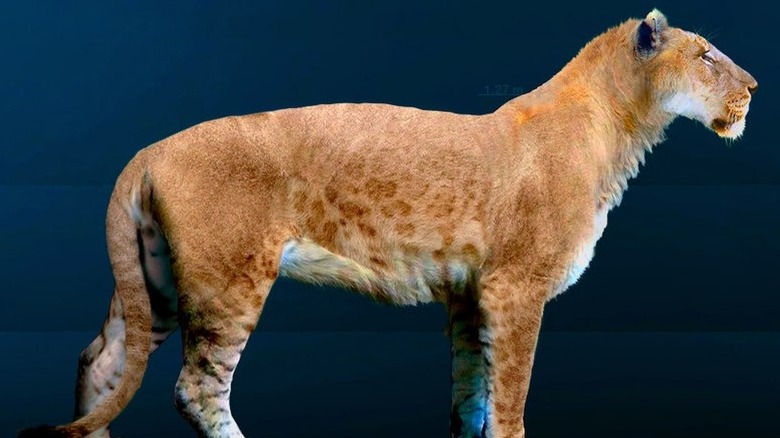The Biggest Theories Why American Lions Went Extinct
So you think racoons are a nuisance? If so, be glad that the American lion went extinct some 10,000 years ago. Weighing in at about 2.77 times the heft of a mountain lion (500 pounds vs. 180 pounds max) but running slower (30 mph vs. 50 mph), the American lion could mess you up real good. As in mangle you and flop you around like a blood-soaked washcloth. Even one of those semi-cowardly black bears who prowl around backyards and snatch food from camp sites would have a tough time standing toe-to-toe with an American lion. Let's be glad that rapid global warming at the end of the last Ice Age killed these cuddly killer kitties. Or humans who migrated to the Americas. Or both.Â
Lions survived for awhile before humans and/or environmental change drove them to extinction. They first appeared on the North American landmass some 165,000 years ago via the same way that humans might have about 20,000 years ago: The Bering Land Bridge connecting Russia to Alaska. They stalked the lands of future Canada down to New Mexico along with other megafauna, all of which went extinct: saber-toothed cats, extra-big bison, mastodons, mammoths, horses, dire wolves, ground sloths, and more.Â
We frail-bodied apes create decent tools and throw spears adequately. But it seems implausible to think that those hunter-gatherers living in North America around 10,000 years ago were solely responsible for the decimation of the mammoth (pun intended) American lion species. More likely, it was a combination of lethal humans plus climate change.
Theory 1: Climate change killed them
When we say that "climate change" might have killed off the American lions, we don't mean the modern kind of man-made global warming that started during the Industrial Revolution. We mean the natural kind that occurs in cycles over Earth's entire history. Specifically, the end of the last Ice Age around 10,000 years ago, when Earth went through a rapid heating period.
Currently, Earth is in the Holocene Epoch, a very slim sliver of geological time — 11,700 years ago to the present — out of the planet's entire 4.5-billion-year history. It has been characterized by the rise of — surprise, surprise — those clever, tool-making apes we described earlier. Earth is, in fact, in an interglacial period. We live in a time of transition out of the previous Ice Age, i.e., the Pleistocene Epoch that lasted from roughly 2.6 million years ago to around 11,000 years ago.Â
In fact, the last Ice Age technically hasn't ended. Nonetheless, things heated up rather quickly — geologically speaking — during the junction from Pleistocene to Holocene Epochs. Glaciers, which used to cover 30% of Earth's surface and extend all the way down to Illinois and Missouri, rapidly melted. White Sands National Park was something of a muddy wetland at that point, and American lion fossils have been found there from well before it became an expanse of desiccated white sand dune.
Theory 2: Humans killed them
The rise of humanity goes hand in hand with the transition from the Pleistocene Epoch to the Holocene. This was a very fortuitous turn for us humans, as it allowed us to develop agriculture, explore Earth in glacier-less environments, migrate around, and so forth. But it can be tricky to extricate the presence of human hunter-killers from the climate changes of the time. Nonetheless, it's possible that humans contributed to the American lion extinction project.
We say "possible" because recent studies have disproved the old idea that hide-clad hunters wielding stone-tipped spears encircled all the megafauna across the American continent and stabbed them all to death. Per NPR, researchers at the archaeology lab at Kent State University did find evidence of human encampments established to hunt down megafauna like mammoths. But as the interview says, a "dozen or so sites where mammoth bones and stone tools were found together are not a smoking gun" for the idea that humans hunted the megafauna — including lions — to extinction. Similarly, the University of South Carolina reports on research that draws from forensics evidence of animal blood on stone tools. Researchers found bison and bear blood, but nothing larger — just deer and rabbits.Â
It stands to reason that some extremely brave and/or stupid and/or really hungry early American humans could have hunted lions. Such pursuits could have contributed to the lions' extinction if they killed them at a fast-enough pace, yes. But humans being totally responsible? It's one of the many things people get wrong about the Ice Age. No one's that hungry.
Theory 3: It was a combo job
Like we've more or less already said, the third possibility regarding what made American lions go extinct seems the most feasible and realistic: The Lions went extinct from a combination of factors. In this case, we mean climate change at the transition from Pleistocene to Holocene Epochs plus the presence of semi-settled humans on the North American landmass around that time. While it doesn't seem like that humans stalked the plains and wetlands hunting lions as much as they did, say, rabbits, it's at least possible that human interaction with the greater biosphere balance impacted American lions' survivability. The theory avoids typical either/or arguments, which are almost always reductionist.
There's evidence for this possibility in the same area of the modern-day United States cited above: White Sands National Park in New Mexico. We know that lions lived in this region because of fossil evidence around what was once Lake Otero, a big freshwater lake that dried up from 10,000 years ago to the present. Its evaporation left behind dry lake beds containing sediment, which the wind blew into today's dunes. Fossilized American lion footprints have been found in this area around what was once the edge of the lake.Â
As the National Park Service explains, we've also got loads of fossilized human footprints from the exact region. Notably, they're arrayed in patterns indicating labor and the division of tasks. At the very least, it's clear that humans in the area were going about their daily business within striking range of nearby lions.
[Featured image by Sergiodlarosa via Wikimedia Commons | Cropped and scaled | CC BY-SA 3.0]



